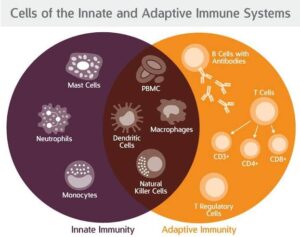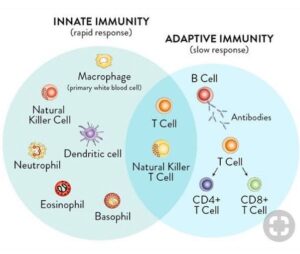Back to: MICROBIOLOGY 100 LEVEL
Welcome to class!
You’re growing into a brilliant microbiologist-in-training, and today’s topic will help you understand how your body defends itself daily. Every time you catch a cold and recover, or when a mosquito bites you and you don’t fall ill, your immune system is hard at work. In this lesson, we’re going to understand the two types of body defence mechanisms: Innate immunity and Adaptive immunity.
Innate Vs. Adaptive Immunity
The immune system is like a security system for the body. It works day and night to detect and fight harmful invaders like bacteria, viruses, and fungi. This system has two main arms—innate immunity, which acts fast and is always ready, and adaptive immunity, which is slower but smarter and more specific.

Innate Immunity
Innate immunity is your body’s first line of defence. It’s what you’re born with and it responds quickly—within minutes to hours—whenever something harmful enters your body.
Features of Innate Immunity:
Non-specific: It does not target a specific microbe, it fights all invaders the same way.
Immediate response: Acts as soon as a threat is detected.
No memory: It doesn’t remember past infections.
Components:
Physical barriers: Like skin, which blocks microbes from entering.
Mucous membranes: Found in the nose, mouth, and gut; they trap and flush out microbes.
Cells: Such as neutrophils, macrophages, and natural killer cells that attack invaders directly.
Chemicals: Like stomach acid and enzymes in saliva that destroy microbes.
Example: When you step on a rusty nail, your innate immunity kicks in immediately—blood rushes to the area, white blood cells arrive to destroy bacteria, and the skin becomes red and swollen (inflammation).
Adaptive Immunity
Adaptive immunity is your body’s second line of defence, but it is more specific and powerful. It develops over time as your body encounters and learns about different pathogens.
Features of Adaptive Immunity:
Specific: Targets particular microbes with precision.
Takes time:Can take days to develop when first exposed to a new pathogen.
Has memory: Remembers past infections and responds faster next time.
Components:
Lymphocytes: White blood cells like B cells (which produce antibodies) and T cells (which kill infected cells or help other immune cells).
Antibodies: Proteins made by B cells that recognise and neutralise specific pathogens.

Example: After recovering from chickenpox, your adaptive immune system remembers the virus. If the same virus tries to attack again, your body fights it off quickly, often without you even noticing.
How They Work Together
Innate and adaptive immunity are not separate teams—they work together. The innate system starts the fight immediately and also alerts the adaptive system to join in. Once the adaptive system responds, it does a more targeted attack and remembers the invader for future protection.
Summary
- Innate immunity is the body’s fast, general defence system. It includes barriers like skin and cells that attack invaders immediately.
- Adaptive immunity is slower but specific. It remembers pathogens and fights them more effectively in future infections.
- Innate immunity has no memory, but adaptive immunity can remember and learn.
- Both systems work together to keep the body safe from disease-causing organisms.
- Examples of adaptive immune tools include antibodies and lymphocytes like B and T cells.
Evaluation
- What are two key differences between innate and adaptive immunity?
- Name one component of the innate immune system and one of the adaptive immune system.
- Why is adaptive immunity considered “smart”?
Understanding how your body fights infection helps you appreciate the beauty and intelligence of nature. Keep up the great work—you’re becoming wiser and more capable every day. Afrilearn is proud to walk this journey with you. Let’s meet again in the next lesson—you’re going higher!
